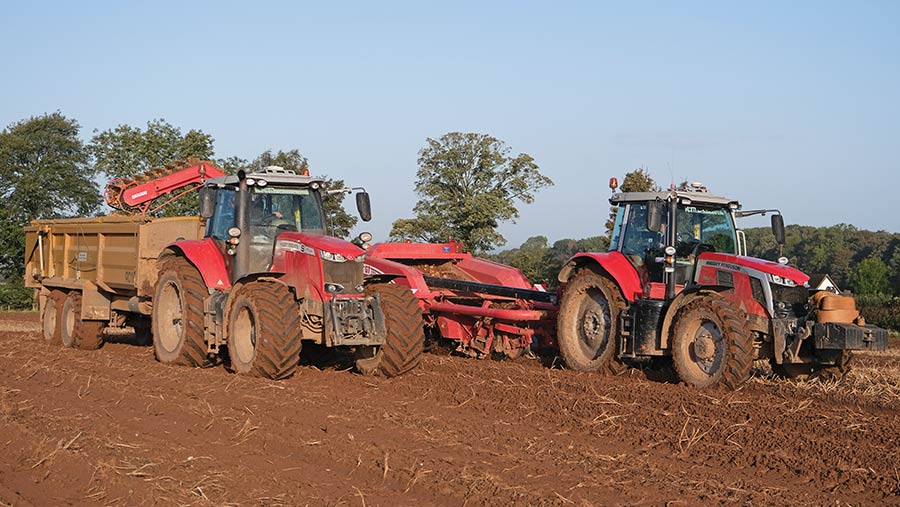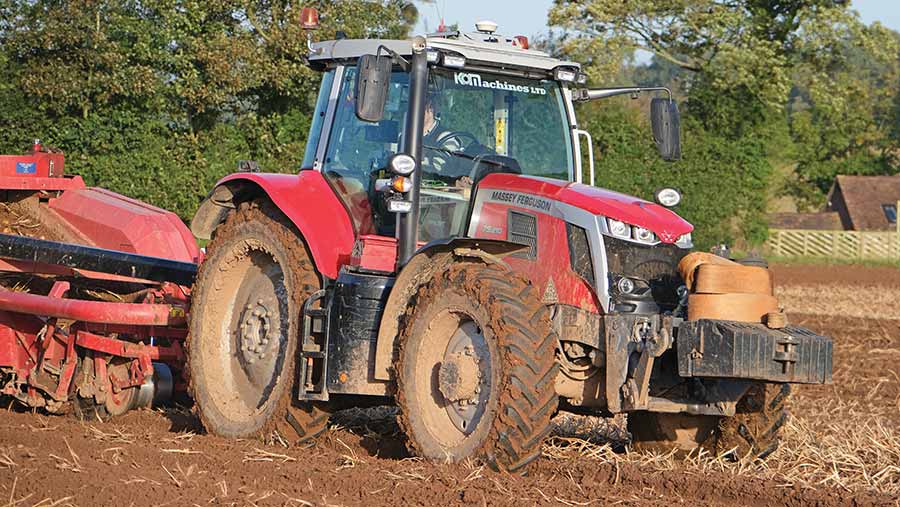Driver’s view: Shropshire farm rates Massey Ferguson 7S.210
 © James Andrews
© James Andrews The 7S.210 might be the smallest tractor in G&J Belcher and Sons’ all-Massey fleet at Puleston Farm in Newport, Shropshire, but this compact powerhouse has still had to tackle the big jobs.
Surrounded by large-frame 7700-series machines – a 7720, 7720S, and 7724S – it’s been used to run most of the same kit.
This ranges from a six-furrow Kuhn Vari-Master plough and 3m Sumo Trio to a 6.5m Vaderstad Carrier and Grimme GT170 spud harvester.
See also: Owner rates Massey Ferguson 8S.265 tractor with Dyna E-Power transmission
Owner Nick Belcher and driver Liam Kennedy give us the rundown on why they picked it and how well it’s gone during its first 1,000 hours of work.
Why a 7S.210?
When the 8S came out we thought it was a bit bigger than we needed, and it didn’t initially have the option of a Dyna-VT transmission. We tried the E-Power, which didn’t impress, and the Dyna-7 semi-powershift.
But for the work we’re doing nothing can match a CVT. Even though it was smaller and lighter than tractors we’d had before, the 7S.210 seemed like the most sensible choice.

© James Andrews
How has it performed?
Power is impressive for its size and it probably has the edge over our 7720s.
It coped fine working the Sumo at up to 250mm (16in) deep, and pulled both the plough and Carrier with ease, although it isn’t the first tractor we go to for these jobs.
Instead, it spends about 70% of the season on row crops, carrying out jobs like destoning and spud lifting.
It handles the GT170 harvester well, but when we’re in sticky conditions and need to use the wheel drive flat out, it takes most of the power it’s got in reserve.
When it’s back on the wide tyres, it gets used for fert spinning, muck carting and muckspreading.
The only time you really notice that it’s smaller and lighter than the other tractors is when there’s a fully loaded 18t trailer on the back.
It has ample power for the job, but it does get pushed around a bit more.
It’s also nippy on the road and it’s amazing how quickly it gets up to speed. With nothing on the back, it’ll accelerate faster than a lot of cars up to 50kph.
Reliability has been good so far, with the only niggle being a wheel angle sensor. As with breakdowns we’ve had on other tractors our dealer, KO Machines, has always given us good backup.
Like all modern tractors, the emissions systems can be a bit of a faff and we have had to do a couple of static regens, which take about half an hour.
What do you think of the updated controls?
All the updates to the controls are a noticeable improvement, particularly the fact that you can now drive on the stick or pedal without having to select between them.
The programmable F buttons on the joystick are handy too, so functions can be moved around depending on the job we’re doing.
Updates to the Datatronic 5 software have made it quicker to find and adjust the settings, and it’s nice that it controls all functions, rather than having some on the small dash screen.
What could be improved?
The performance of the tractor and the way it works is great, but the cab is small and dated – so much so, that it’s a challenge to find enough places to mount control boxes.
To get around this, we’ve had to get creative by building extra brackets that make use of all the available space.
Massey’s decision to squeeze a lot of new technology into an old cab also causes a few problems, such as the armrest hitting the side console when you turn the seat.
Another bad one is the fact that the hydraulic joystick can collide with the bottom of the screen when the seat bounces, causing the front linkage to drop.
Other than that, it’s a well sorted machine that does most of what the larger tractors can do in a handier, compact package.

